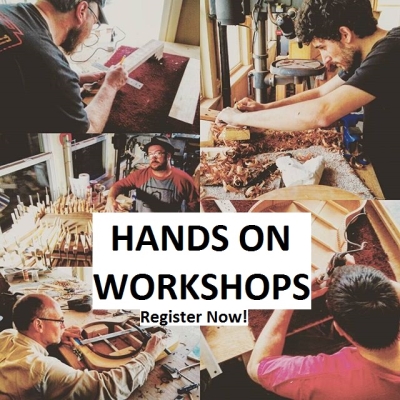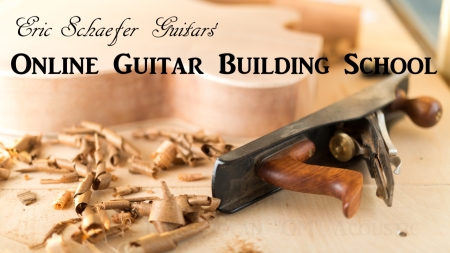 Eric Schaefer Guitars’ Online Guitar Building School
Eric Schaefer Guitars’ Online Guitar Building School
This is a free video from the “Building an OM Acoustic” Course. Click here for more free video tutorials.
In this lesson we will discuss various tools around my shop. This is just to get the gears turning in your head. This is not meant to be a comprehensive list of necessities. I urge the student to make NO tool purchases at this time. It is much wiser and more economical to rent, borrow or purchase tools as you go, lesson by lesson. Not every builder uses the same tools so you may find that your situation calls for a different setup than mine.
Lesson Transcript:
The last two lessons prompted you to take action: to order a set of plans and to order the parts and materials for your guitar. This lesson, however, is going to be just a little bit different. I urge you to put away the credit card for now and just listen. I am going to show you some of the tools around my shop. some of these tools are totally necessary while others are just plain fun, or they make the job easier.
You are encouraged to take notes but not encouraged to purchase any of the tools you see here… yet.
What I really want you to do is this: As you go through the content of this course, lesson by lesson, purchase the tools as you go. It is much smarter that way. You will end up making wiser purchases and you won’t have any extra junk tools around the shop that you never really use.
I also encourage students to rent or borrow tools as much as possible. There is likely a woodshop or maker’s space in your area where you can rent time, especially on some of the larger equipment such as thickness sanders or bandsaws.
Call up some friends. Look on Craig’s list. It is very likely that a lot of these tools are right under your fingertips if you look hard enough.
#5 Jack Plane
The #5 Jack Plane finds a myriad of uses around my shop, most notably for jointing long edges, such as the joint for the top and back plates. I also use this general purpose plane for thicknessing stock before fine-tuning the thickness on a drum sander.
Thumb Plane
This miniature handplane made from an ebony block is called a thumb plane. It is certainly not a necessity, but it does make some jobs, like trimming brace tops, a whole lot of fun.
Block Plane
The block plane is an excellent companion to the jack plane. The block plane is useful for jointing edges and thicknessing small surfaces such as the scarf joint for the neck.
Chisels
I use 4 chisels for work on guitars. I use a 1″, 3/4″, 1/4″ and an 1/8″ chisel. It is wiser to invest in a good quality 1″ and 1/4″ chisel, rather than a whole set of cheap, low quality chisels. I do, however keep some bargain variety chisels, such as this one, around for general use in the shop, just to save the edge on my good chisels.
Spokeshave
The spokeshave was designed for use in shaping and smoothing curved surfaces, such as chair legs, wheel spokes and, in this case, guitar necks. Make sure your spokeshave has a flat plane (*sole) rather than a radiused plane (*sole).
Card Scrapers
Card scrapers are great for smoothing surfaces if you know how to sharpen them and use them. Otherwise, you can just use sandpaper for smoothing. In a pinch, a razor blade can quickly and easily be honed into an effective mini-scraper, simply by drawing the razor’s edge across an edge of hard steel, such as the edge of your bandsaw table.
Large Backsaw
The backsaw is designed for precision cuts. Unlike most other saw types, the backsaw has a metal rib, opposite the cutting edge, to limit flexing of the blade. The only drawback is that the metal rib prevents you from cutting beyond a certain depth. The larger variety of backsaws, which you see here, is not of much use unless you do not have access to power tools and need something heavy duty for cross cuts.
Dovetail Saw
The dovetail saw is a small backsaw set to leave a narrow kerf. I keep 2 10″ dovetail saws on hand: A low quality saw for my rough cuts and a high quality saw with a kerf specifically designed for cutting fret slots.
Japanese Pullsaw
The Japanese pullsaw has a thin blade and it cuts on the pull stroke. This saw doesn’t see a whole lot of action in my shop because I do my rip cuts on the table saw or the bandsaw. However, if you are working without the use of power tools, then the pullsaw may be a viable option.
Razor Saw
The razor saw can be found at hobby stores. It is similar in form and function to the dovetail saw, just scaled down a bit. I use this saw to cut notches in my braces.
Coping Saw
The coping saw is designed for cutting curves. I keep one around for a number of uses but, more often than not, the bandsaw replaces my need for a coping saw.
Jeweler’s Saw
The jeweler’s saw, on the other hand, is irreplaceable for fine inlay work. This is essentially a superfine coping saw. I use fine and extra fine blades. The blades come in packs of 20 or more because breaking a blade is a relatively common occurrence.
Cam Clamps
Wooden cam clamps are the backbone of a luthier’s clamp supply. They are lightweight, quick and easy to use, have a secure grip and a high clamping pressure, though not as high as other clamps.
C-Clamps
C-Clamps are a bit more heavy duty. If you’re just getting started I would recommend picking up 4″, 1 1/2″, and some deep reach c-clamps. I would recommend 2 of each.
“Ibex” Bridge Clamps
Ibex bridge clamps are lightweight clamps designed specifically for gluing the bridge to the soundboard.
Spring Clamps
Spring clamps are lightweight, low cost, and even easier to use than cam clamps. Just squeeze the trigger and release. The tradeoff is in strength. Spring clamps are only as strong as their spring. They are great for any situation where you simply need an extra hand. The relatively light hold is enough for aligning and marking out dimensions.
Files
A variety of flat, round and triangular files find many uses throughout the build process. These need not be expensive items. In fact, a single set containing a variety of files can be purchased for very cheap at most hardware stores. Make sure your file set includes a rasp.
Needle Files
Needle files are equally useful and equally inexpensive. Once again, you will want a variety of flat, round and triangular files.
Nut Slotting Files
As the name implies, nut slotting files are designed specifically with nut slotting in mind. The nut slots are cut to the exact diameter of that slot’s string or slightly larger. Therefore, you will need a variety of nut slotting files to match or very nearly match the gauges of your strings.
Razor Knife
A razor knife with a variety of razor blade attachments can be immensely useful, and for very cheap. I also keep single edge razor blades handy for use as mini scrapers among other uses.
Fret Nippers
Any set of strong nippers will work but I like these fret nippers from Stewart Macdonald because the front face is ground flat, allowing the nippers to reach in flush with the fretboard. Of course, you can always use an ordinary set and grind the front face flat yourself.
Fretting Hammer
An ordinary carpenter’s hammer will not work for hammering frets, as it will mar the fretwire. The ideal fretting hammer is lightweight and has a plastic or a brass head. The hammer I most commonly use is filled with shot, making it a deadblow hammer. This reduces recoil and makes fretting just a little bit easier.
Fret Press
You can also avoid hammering altogether, and press your frets in instead. I often hammer my frets in but then use the Jaws II fret press, pictured here, to press in any fret ends that did not seat well.
6″ Square
A 6″ square of decent quality should be the only square that you need for marking and checking for square.
Straightedges
Reliable straightedges are essential. For guitar work, it is good to have an 18″ and a 24″ straightedge. I also own a notched straightedge. This straightedge is notched to fit over the frets. That way I can check the relief of the fretboard without the frets interfering with the measurement. This is, of course, useful for guitar setup and repair work.
Tools noted:
#5 Jack plane
Thumb Plane
Block Plane
Chisels
Spokeshave
Card Scrapers
Dovetail Saw
Japanese Pullsaw
Razor Saw
Large Backsaw
Coping Saw
Jeweler’s Saw
Cam Clamps
C-Clamps
Ibex Bridge Clamps
Spring Clamps
Files
Needle Files
Nut Slotting Files
Razor Knife and Razor Blades
Fret Nippers
Fretting Hammer
Fret Press
6″ Square
Straightedges
Caliper
Feeler Gauges
Protractor
Radius Gauges
Radius Blocks
Fret Bender
String Spacing Ruler
Heat Gun
Drill
Laminate Trimmer
Plunge Router
Various Rulers
Inspection Mirror
Dremel Tool
Bending Iron
Random Orbital Sander
Dremel Base
Circle Cutter
Equipment:
Bandsaw
Bench Grinder
Belt Sander
Drill Press
Router Table
Table Saw
Drum Sander
Was this useful? I would love to hear your questions or comments! I try to answer every e-mail I receive, so please be patient with me ![]() eric@ericschaeferguitars.com
eric@ericschaeferguitars.com
Want more of this? Subscribe below for Weekly Guitar Making Tips on “The Small Shop Luthier Blog”
Want to learn more? Take a class with Eric Schaefer and build your own guitar in 8 days


